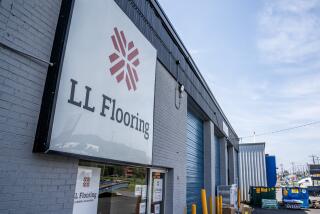Home Fabrics Giant Cuts Pattern for Survival : Sherman Oaks Firm Faces Stagnant Market With Bigger Stores, Acquisitions
- Share via
House of Fabrics Inc., the Sherman Oaks company that wants to sew up the home fabrics market, might have been called Cart of Burlap, considering its humble ancestry: During the Depression, old Barney Sofro clopped around the hills of western Massachusetts in a horse-drawn wagon, collecting used burlap for resale.
Today, the offspring of that burlap business, House of Fabrics, has 760 stores, $278 million in annual sales, a strong balance sheet, a dominant position in its field and big plans for expanding its share of the $3-billion-a-year business of selling fabrics and accessories to people who sew at home. And it is still run by the Sofro family.
But the company had a disappointing fourth quarter, ended Jan. 31. It also sees a drop in earnings for the first quarter of this fiscal year. After the unspectacular earnings news, merger talks collapsed last week between House of Fabrics and privately held Home Silk Shop of Los Angeles.
Stagnant Market
On top of all that, the nation’s largest home-sewing fabric seller faces a stagnant or shrinking market. A lot has changed since House of Fabrics opened its first store in 1946 on Wilshire Boulevard, and now the company must cut itself a pattern for survival that fits the radically different role of women--its primary customers--in American society.
Not to worry, says David Sofro, the company’s crusty 73-year-old chairman, whose father and son are both named Barney. David moved the Sofros to California, where he used some of what he learned of fabrics from his father’s horse-powered business to start House of Fabrics after World War II.
“I’ve spent 50 years of my life in this business, and this is the most misunderstood business you can think of,” he said, surrounded by the paraphernalia of his passion for horse racing. “The true story is this: when women go to work they need a much larger wardrobe. The larger the wardrobe, the more they’re going to sew.”
Indeed, although more than half of American women are in the work force, their median full-time pay is less than two-thirds that of men, and cost savings are the main reason most House of Fabrics customers sew, the company’s market research shows. About 60% of its customers work.
Fiscal Year Profits Up
That, the company says, has helped boost House of Fabrics to higher sales every year, with generally strong earnings as well. Profits were $11.3 million on sales of $278.3 million in the fiscal year ended Jan. 31, up from $9.7 million on sales of $239.6 million in the preceding 12 months.
Although the company’s fourth quarter was not quite up to expectations--profits rose only $500,000 to $3.9 million, although sales were up 17% to $81.9 million--and its first quarter is expected to be off from last year’s, these things are not considered disasters by market analysts.
“In my opinion they’re good merchants,” said Dan Williams, who follows House of Fabrics for Sutro & Co., a San Francisco brokerage firm.
House of Fabrics attributes its lackluster results to bad weather that forced many store closings in January, the need to hold sales in December and January, and a shorter Easter selling season.
‘A Cyclical Company’
What’s more, as the company moves more heavily into sewing machines and craft items, its business becomes more dependent on Christmas sales, the Sofros say.
“We’re a cyclical company today,” David Sofro said. “We never were before.”
Williams played down the collapse of the company’s merger plans, saying other mergers are likely to come as smaller-scale entrepreneurs sell out. “Most of the business is done nationwide by a lot of mom-and-pop locations,” he said. “These people are getting old and are going to look for liquidity.”
Neither Barney Sofro nor Murray Pepper, president of Home Silk Shop, would comment on the merger collapse, except to say that they mutually agreed to terminate the talks. In April, Pepper’s company, with sales of nearly $20 million, signed a letter of intent to be acquired by House of Fabrics.
The Right-Size Stores
House of Fabrics wanted Home Silk because its 23 stores in greater Los Angeles and one store in Phoenix range in size from 8,000 to 26,000 square feet--just the kind of big stores House of Fabrics wants now. The deal also would have strengthened House of Fabrics in its own backyard.
Nevertheless, the exit of mom-and-pop stores is good news for House of Fabrics, which plans to prosper by capturing a greater share of the highly fragmented business. It hopes to accomplish that by moving out of shopping centers and malls, where it has most of its stores, and onto neighborhood thoroughfares.
It also plans much bigger stores, and is selling more crafts and sewing machines in addition to fabrics, which nowadays account for just 47% of its sales. The company says it already is the nation’s largest seller of Singer products.
The home-sewing business is not as fragmented as it once was. Fifteen years ago, most experts say, there were perhaps 40,000 stores selling fabrics and sewing notions. Now there are about 10,000, and 43-year-old Barney Sofro, president and chief executive of House of Fabrics, says that number will probably fall further.
Department Stores Out
Only five to eight retailers are considered major players in the field. Department stores, once prominent purveyors of home-sewing fabrics, have mostly abandoned the business, which is labor- intensive and relatively low-profit. As Barney Sofro said, “The home sewing business is undergoing some real tension.”
Still, there are 43 million home seamstresses in this country, according to Michael Feuer, senior vice president of House of Fabrics’ biggest competitor, Cleveland-based Fabri-centers of America Inc., and they are not all old, or old-fashioned. House of Fabrics, the leader with just 9% of the market, says the average age of its customers is 35.
The Sofros, who hold 11.6% of the company’s stock, are counting to a great extent on acquisitions, which they hope to finance without long-term debt.
In June of 1983, House of Fabrics bought the 24-store Beaconway Corp. chain, based in Framingham, Mass. In February, 1984, the company acquired the 35-store Craft Showcase chain, based in Cleveland. Recently, House of Fabrics bought Yardage Fair Inc., a 12-store chain in Northern California with the kind of big stores--10,000 to 20,000 square feet--that the Sofros want.
‘Super Stores’
But House of Fabrics has not just worked through acquisitions. In November of 1983, the company opened its first non-mall “super store,” a 12,000-square-foot outlet in Tempe, Ariz., that dwarfs the typical 4,000-square-foot House of Fabrics or So-Fro store. (The company uses the So-Fro name for most of its stores east of the Rocky Mountains.)
It added 17 more super stores around the country during 1984 and plans 50 or 60 for this year, the Sofros say.
They also say that, although no acquisitions are likely this year, more are possible afters that.
In any case, there are other factors that the Sofros see brightening the future of House of Fabrics. They say there is a renewed concern with quality, and home-made craftsmanship should keep home sewing popular, even if there is no growth. New, easier-to-use sewing machines are said to be on the horizon. Patterns are simpler than ever. Fabrics are easier to work with.
Barney Sofro talks of a society in which women are once again wearing dresses, and traditional skills such as sewing are appreciated. “We think the conservative mood of the country augurs well for home sewing,” he said. “We’re looking for a strong year.”
More to Read
Inside the business of entertainment
The Wide Shot brings you news, analysis and insights on everything from streaming wars to production — and what it all means for the future.
You may occasionally receive promotional content from the Los Angeles Times.









